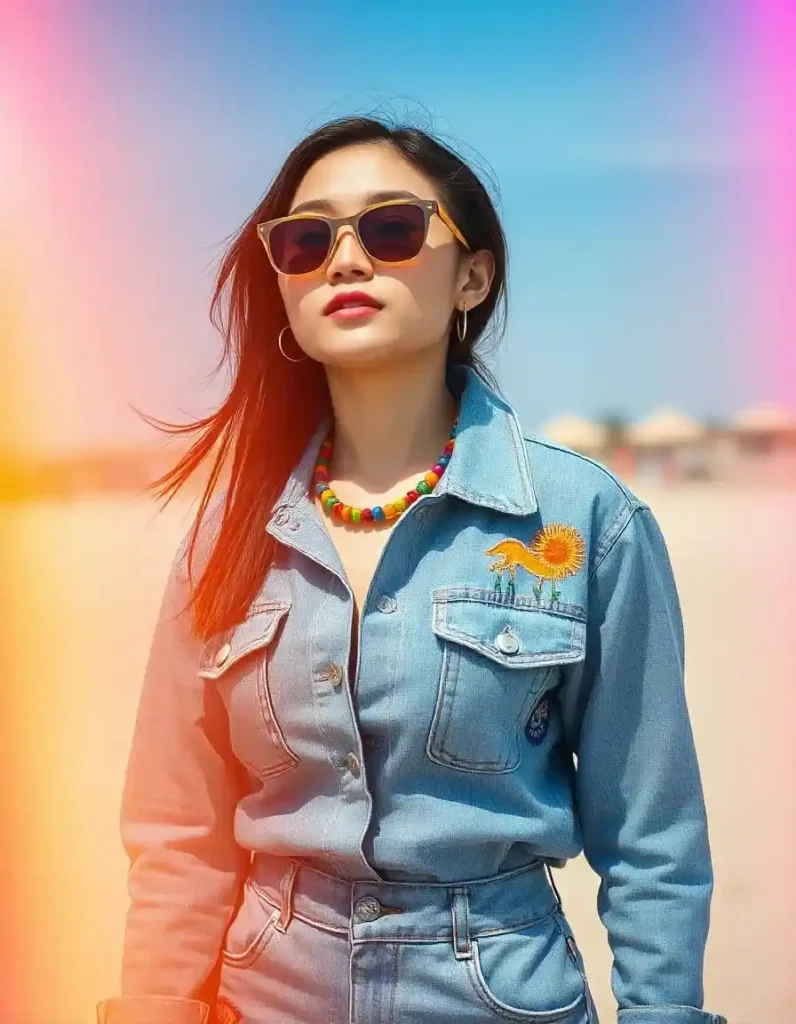In today’s social media and street style, the concept of matching fashion has become more than a trend—it’s a style statement. Outfit matching creates a platform through which you can unleash your creativity and at the same time ensure that all of you are in harmony with the theme, dance, or just styling with your partner or the whole family.
When people speak about fashion that matches it is not only the colors and the patterns that should be matched with each other but the overall appearance should be so balanced that the eye should rest on it and the overall picture that it gives should be vibrant and louding fashion doesn’t just mean copying colors or patterns; it’s about creating a balanced, harmonious appearance that catches the eye and makes a bold statement.
Imagine turning heads at an event with outfits that are color-coordinated or reflect a particular theme. Matching fashion isn’t just for the runway or celebrities; anyone can embrace this trend with the right insights! In this guide, you will find all the basics and helpful tricks about matching, colors, accessories, seasons, and much more as well as a section for those on a limited clothing budget.
Why not turn your wardrobe into a stylish scenario, masterpiece, or well-titled coherent style?
What is Matching Fashion, and Why is It Trending?
Understanding the Basics of Matching Fashion
At its core, matching fashion is all about creating harmony in your look. Matching outfits don’t necessarily mean identical pieces; they involve coordinating colors, patterns, and styles to create a look that appears effortlessly cohesive. It is now observable that this trend has origins in several fashion movements and can trace its origins back to high fashion, where designers produced whole seasons’ worth of motifs and corresponding garments that revolve around the concept of pairing.
The Rise of Matching Fashion in Social Media and Pop Culture
Social media has been a major driver for the matching fashion trend. From famous Hollywood couples to paid enthusiasts, Instagram and TikTok personas, coordinating looks are in the trend. According to a 2022 survey by Statista, 45% of social media users follow influencers and celebrities for style inspiration, with “matching fashion” tagged over 1.5 million times on Instagram alone. The visual nature and the plainness of matching costumes is what make it possible to share the outfits, as well as imitate them.
Mastering the Art of Color Coordination
The Basics of Color Theory in Fashion
Speaking from a color theory point of view, color coordination in fashion is rather crucial, especially for those aspiring to be styled. The three primary color schemes—monochromatic, complementary, and analogous—provide a framework for selecting harmonious colors.
- Monochromatic: Sticking to shades and tints of a single color. Think all-beige or all-navy outfits, which offer sophistication and elegance.
- Complementary: Using colors opposite each other on the color wheel (e.g., blue and orange) creates contrast and vibrancy.
- Analogous: These are colors next to each other on the color wheel, such as blue, green, and teal, creating a more seamless and relaxed look.
Color Psychology in Fashion
Color regulation is another critical form of regulation in matching fashion as different colors create responses in people. For instance, associating shades of blue will make people be calm and dependable while the energy of the color red will enhance energy and assurance. To know what mood you want to create, you need to learn about color psychology and create outfits to reflect that mood.
Outfit Matching for Every Occasion
How to Match for Formal and Casual Settings
Matching outfits aren’t just for casual settings; they’re adaptable for all kinds of occasions. Here’s how to ace matching fashion in different environments:
- Formal Occasions: Opt for monochromatic or neutral tones like black, navy, or grey for an elegant and polished appearance. Adding matching accessories, like a pocket square or scarf, adds a subtle touch without being overwhelming.
- Casual Outings: Play around with bolder colors or patterns. For instance, pairing a graphic tee with matching sneakers or a floral dress with a coordinating hat can elevate even a laid-back look.
Adding Accessories for Extra Coordination
Accessories can make or break a matching outfit. When done right they give character and cohesion to your style. For example, matching your belt with your shoes or adding jewelry that complements the color scheme can make your outfit feel more intentional. The goal is not to overdo it but to add just enough to create cohesion.
Coordinating Couple and Family Outfits
Couple Matching Fashion: A Growing Trend
Fashion statements done in pairs have become trendy as couples want to show the world how great their relationship is as well as the fashion sense they have in common. According to Pinterest, searches for “matching couple outfits” rose by 65% in 2023, showing a continued interest in coordinating looks. Here are a few ideas for couple coordination:
- Classic Matching: Using complementary or monochromatic color schemes.
- Subtle Elements: Matching small details, like wearing the same color shoes or sharing a similar accessory.
Family Fashion: Coordinating Without Going Overboard
Coordinating family outfits doesn’t mean everyone has to wear the same thing. The key is to make sure that the color scheme that a person selects is used in all the outfits. If the parents are dressed in shades of blue the kids can put in some blue by putting on something blue like a tie or socks. This practice of matching fashion for the family has become common practice during events and photoshoots, therefore providing a lasting visually appealing appearance of togetherness.
Seasonal Matching Trends
Fashion for Every Season
Each season has its own style trends that lend themselves well to matching fashion:
- Spring: Pastels and floral patterns are the go-to. Matching pastel outfits or incorporating floral accessories can give a fresh, coordinated look.
- Summer: Bold, bright colors and lightweight fabrics like linen are perfect for hot weather. Coordinated beachwear, like matching swimsuits or summer hats, is always in style.
- Autumn: Earthy tones, such as browns, oranges, and greens, are ideal. Plaid and layered outfits can create a cohesive look without looking too “matchy-matchy.”
- Winter: Darker hues and heavier fabrics work well. Consider matching scarves, coats, or hats in neutral or jewel-toned colors for a cozy yet stylish look.
Trends in Sustainable Matching Fashion
Sustainable fashion has become a top priority for many, with a study from McKinsey showing that 67% of consumers now consider sustainable materials when shopping. It is easier to wear separate garments all through several seasons if the pieces chosen are classics with simple colors and prints. This ensures that when dressing in the morning there is more possibility to combine outfits from different seasons before washing some of the pieces. Sustainability-oriented brands usually release items that share the same color palette to help incorporate pure and easily mix and match the garments.
Matching Accessories and Footwear
Coordinating Shoes, Bags, and Jewelry
Cladding completes the look as accessories do. Choosing shoes, bags, and jewelry that match or complement the color scheme of your outfit can tie everything together. For instance, if you’re wearing a white and blue outfit, a pair of blue shoes or a white handbag can make the outfit feel polished and intentional.
Tips for Minimalist vs. Bold Matching Styles
If your style leans minimalist, opt for subtle accessories like a watch or delicate jewelry that complements your outfit without overpowering it. If you would like to go for a stronger look, go for accessories that share the brightness of shades or have prints very similar to some part of the attire. In any case, the right prompt can improve your mood or improve your physical appearance. Terence extols this idea in the sense that the right prompt could add style or grace to your general outlook.
Creating a Matching Fashion Wardrobe on a Budget
Thrifting and Shopping Your Closet
Creating matching outfits doesn’t have to be expensive. Thrifting is cost-effective and allows individuals to find nice items that can easily be mixed and matched. Something similar can be achieved by shopping your closet. When using the present clothes in a different combination, then think of how many different combinations can one make without buying anything new.
Investing in Versatile Pieces
When buying clothes be selective to get wardrobe basics that are quality items including pants, good jackets, and good shirts that are pastel in colors. These basics can be worn with different other apparel, meaning that you are going to find so many matching outfits you can wear.
According to a survey by Fashion United, 70% of shoppers prefer investing in classic items they can wear repeatedly, making it a smart choice for building a matching fashion wardrobe.
Conclusion
Matching fashion isn’t just about following trends; it’s a way to express individuality, creativity, and style. From choosing colors that match your personality to selecting accessories that make you unique mastering matching fashion can make an impact wherever you are. By considering factors like color theory, seasonal trends, and your unique taste, you can create a wardrobe that feels cohesive, stylish, and truly “you.” So next time you’re putting together an outfit, remember: a little harmony goes a long way!



